Carrefour Bundle
Who Really Controls Carrefour?
Unraveling the Carrefour SWOT Analysis reveals more than just its strengths and weaknesses; it prompts a critical question: Who truly owns Carrefour Company? Understanding the Carrefour ownership structure is paramount for any investor or strategist aiming to navigate the complexities of the global retail landscape. This exploration delves into the heart of Carrefour's corporate governance, offering insights into its strategic direction and market influence.
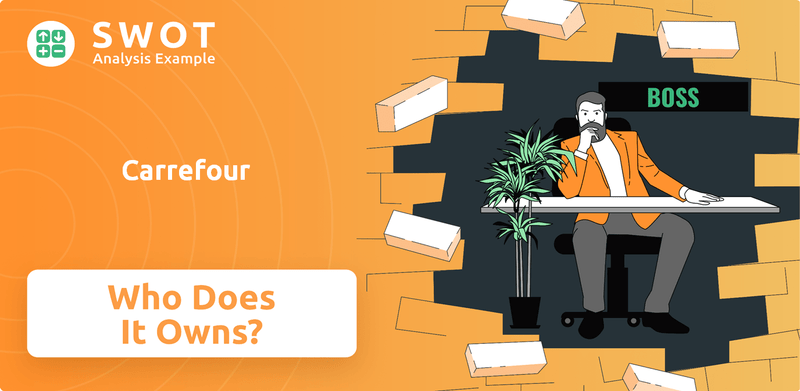
From its humble beginnings to its current status as a retail behemoth, Carrefour's history is intertwined with shifts in ownership and strategic alliances. Knowing who owns Carrefour provides a crucial lens through which to view its operational strategies, investment decisions, and competitive positioning. This analysis will explore the Carrefour parent company, key shareholders, and the individuals shaping the future of this retail giant, including the current Carrefour CEO and their impact on the company's trajectory. We'll examine if Carrefour is a publicly traded company and its market capitalization.
Who Founded Carrefour?
The story of Carrefour begins in 1959, with Marcel Fournier, Denis Defforey, and Jacques Defforey joining forces to create the company. This marked the start of what would become a global retail giant. Their combined expertise and resources laid the foundation for the first Carrefour supermarket, located in Annecy, France.
Initially, the ownership structure was rooted in family involvement. The Fournier and Defforey families held significant control. Their prior experience in retail, including department stores and wholesale, was crucial to the early development and strategic direction of the company. This family-centric approach was key to the company's initial growth and vision.
The founders likely agreed early on to reinvest profits to fuel expansion. The launch of the hypermarket concept in 1963 was a pivotal moment, quickly attracting attention and capital. While specific details on early investors are limited, the company's growth was primarily driven by the founders' entrepreneurial spirit. The founding team remained united, which allowed for swift expansion in the hypermarket sector.
The founders of the Carrefour company were Marcel Fournier, Denis Defforey, and Jacques Defforey.
The primary focus of the founders was to create a one-stop-shop for consumers.
The company's early expansion was driven by the founders' entrepreneurial vision and a conservative approach to external financing.
Carrefour pioneered the hypermarket concept in 1963.
The Fournier and Defforey families held significant control in the early years.
Early growth was largely fueled by the founders' drive and internal reinvestment.
Understanding the early ownership of the Carrefour company provides insight into its foundational values and strategic direction. The initial focus on family involvement and reinvestment set the stage for its future growth. If you want to learn more about the company's current structure, you can find further details about Carrefour ownership.
- The founders' commitment to a unified vision was crucial for early success.
- The hypermarket concept was a key innovation that drove rapid expansion.
- Family control and reinvestment were central to the company's initial financial strategy.
- The early focus on a one-stop-shop approach shaped its retail model.
Carrefour SWOT Analysis
- Complete SWOT Breakdown
- Fully Customizable
- Editable in Excel & Word
- Professional Formatting
- Investor-Ready Format
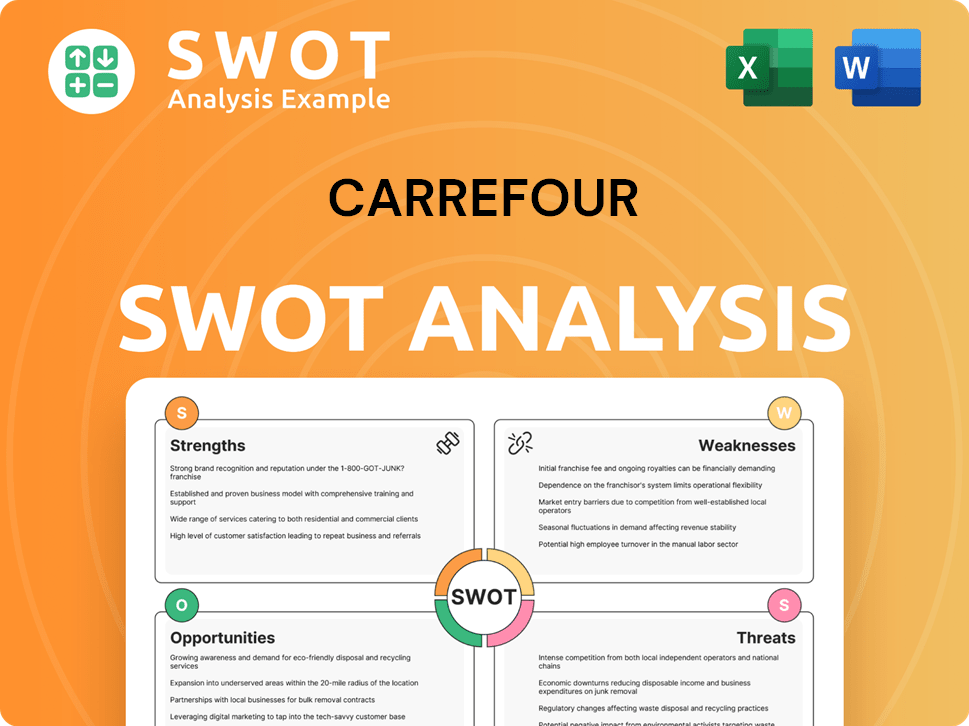
How Has Carrefour’s Ownership Changed Over Time?
The evolution of Carrefour's ownership structure has been marked by key events since its initial public offering (IPO) in 1970. This IPO was a significant turning point, opening the door to public shareholders and gradually reducing the direct control of the founding families. Over the years, institutional investors have gained increasing prominence, shaping the company's trajectory. These shifts in ownership have often coincided with strategic moves, such as market expansions and efforts to boost profitability.
As of early 2025, the ownership landscape of the Carrefour company reflects a diverse mix of stakeholders. The major shareholders play a crucial role in the company's strategic direction. The presence of influential investors like Groupe Arnault and the Moulin family signals a focus on long-term value creation and a keen interest in the company's performance and governance. The changes in shareholding have influenced Carrefour's strategy, particularly in digital transformation, cost optimization, and the development of new retail formats.
| Shareholder | Stake (as of December 31, 2023) | Role |
|---|---|---|
| Groupe Arnault (Financière Agache) | Approximately 6.46% | Strategic Investor |
| Moulin family (Motier) | Approximately 13.62% | Strategic Investor |
| Other Institutional Investors | Variable | Diverse public shareholders |
The current Carrefour ownership structure showcases a blend of strategic and institutional investors. Groupe Arnault and the Moulin family, as major shareholders, exert considerable influence. Other significant stakeholders include institutional investors, mutual funds, and index funds. These entities collectively shape the strategic direction of the company. The ownership structure highlights a focus on long-term value creation and a commitment to enhancing the company's performance. The influence of key shareholders is evident in strategic initiatives, including digital transformation and cost optimization efforts.
The ownership of the Carrefour company has evolved significantly since its IPO in 1970. Major shareholders include Groupe Arnault and the Moulin family, who hold substantial stakes. Institutional investors also play a crucial role in the company's ownership structure.
- Groupe Arnault held approximately 6.46% as of December 31, 2023.
- The Moulin family held approximately 13.62% as of December 31, 2023.
- The shifts in ownership have influenced strategic initiatives.
- The ownership structure reflects a focus on long-term value creation.
Carrefour PESTLE Analysis
- Covers All 6 PESTLE Categories
- No Research Needed – Save Hours of Work
- Built by Experts, Trusted by Consultants
- Instant Download, Ready to Use
- 100% Editable, Fully Customizable
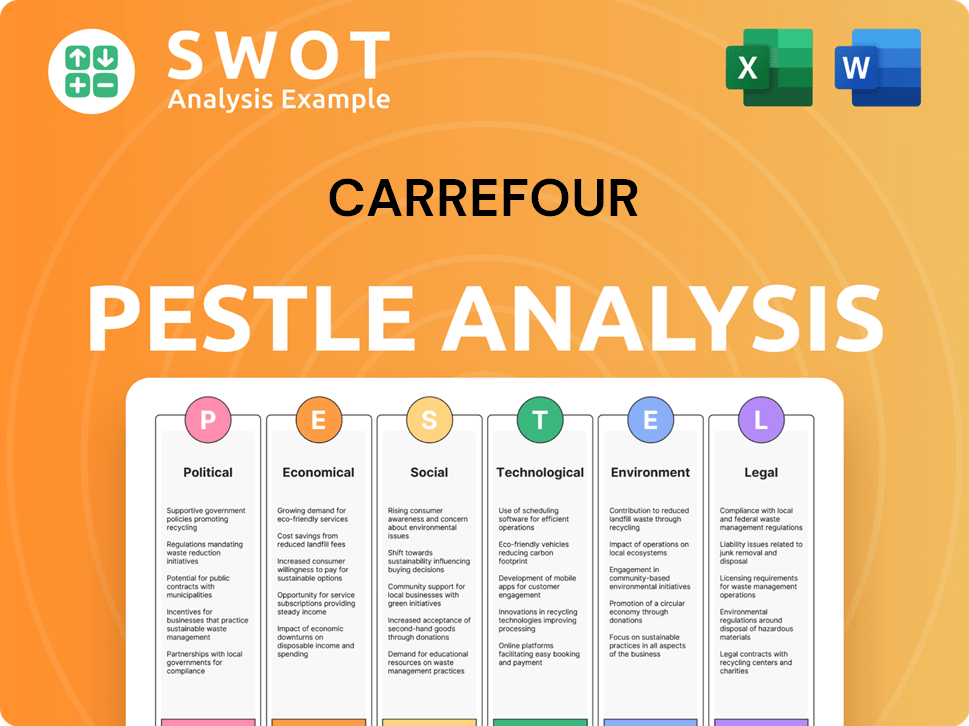
Who Sits on Carrefour’s Board?
The current Board of Directors of the Carrefour company reflects a mix of major shareholder representatives, independent directors, and executive management. As of early 2025, the board typically includes individuals representing key shareholders such as the Moulin family and Groupe Arnault. For example, members associated with the Moulin family, through Motier, and representatives from Groupe Arnault are likely to hold seats, ensuring their strategic input and oversight. The board also includes a significant number of independent directors, which is crucial for maintaining corporate governance standards and ensuring diverse perspectives in decision-making. The Chairman of the Board and the Chief Executive Officer are also key figures, often holding significant influence.
The composition of the board is designed to balance the interests of major shareholders with the need for independent oversight. This structure helps in strategic decision-making and in navigating the complexities of the retail market. The presence of independent directors ensures that the company's operations adhere to best practices in corporate governance. The board's structure is crucial for the long-term success of the company, ensuring that it remains competitive and adaptable to market changes. The board's decisions have a direct impact on the Carrefour's financial performance and strategic direction.
| Board Member | Role | Affiliation |
|---|---|---|
| Alexandre Bompard | Chairman and CEO | Carrefour |
| Representative | Director | Moulin Family (Motier) |
| Representative | Director | Groupe Arnault |
Carrefour generally operates on a one-share-one-vote structure, meaning that each share of common stock grants its holder one vote on matters presented to shareholders. However, the concentration of ownership in the hands of the Moulin family and Groupe Arnault provides them with substantial voting power, allowing them to significantly influence strategic decisions, board appointments, and major corporate actions. While there haven't been widely publicized recent proxy battles or activist investor campaigns that have dramatically reshaped Carrefour's governance in the last year, the influence of these major shareholders is consistently felt through their representation on the board and their ability to shape the company's long-term vision. The balance between the interests of these major shareholders and the broader base of public shareholders is a continuous aspect of Carrefour's corporate governance.
The ownership of Carrefour is primarily influenced by major shareholders and a public float. The Moulin family and Groupe Arnault hold significant stakes, affecting strategic decisions. The board includes representatives from major shareholders and independent directors.
- Moulin family and Groupe Arnault have considerable voting power.
- One-share-one-vote structure is generally in place.
- Independent directors ensure corporate governance.
- The board balances shareholder and public interests.
Carrefour Business Model Canvas
- Complete 9-Block Business Model Canvas
- Effortlessly Communicate Your Business Strategy
- Investor-Ready BMC Format
- 100% Editable and Customizable
- Clear and Structured Layout
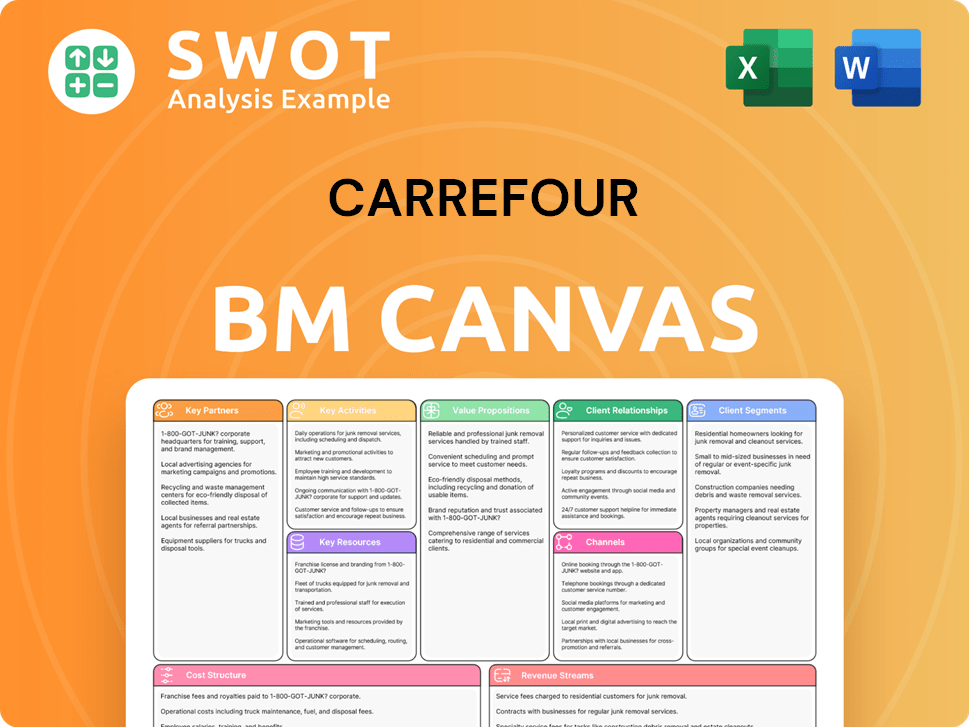
What Recent Changes Have Shaped Carrefour’s Ownership Landscape?
In the past few years, the ownership of the Carrefour company has seen significant developments. The Moulin family, through Motier, and Groupe Arnault have increased their stakes, signaling confidence in Carrefour's future. As of December 31, 2023, the Moulin family held approximately 13.62%, making them the largest shareholder. Groupe Arnault, through Financière Agache, held around 6.46% as of the same date. These increases show a strong belief in the company's performance.
These ownership trends reflect industry-wide shifts towards increased institutional and strategic investor involvement. While there haven't been announcements about major changes like full privatization, the consolidation of stakes by key investors suggests a focus on long-term stability. This stability can enable Carrefour to make bolder strategic moves, such as investing in e-commerce and expanding its store network. The focus on digital transformation and market share is likely influenced by the long-term vision of its major shareholders. If you're interested in understanding the competitive environment in which Carrefour operates, you can explore the Competitors Landscape of Carrefour.
The ownership structure of Carrefour is primarily influenced by strategic investors. The Moulin family, through Motier, and Groupe Arnault hold significant stakes. Institutional investors also play a role, contributing to the stability of the shareholder base. This structure supports long-term strategic planning and investment.
The Moulin family, via Motier, is the largest shareholder, holding approximately 13.62% as of December 31, 2023. Groupe Arnault, through Financière Agache, holds around 6.46% as of the same date. These key shareholders are instrumental in shaping the company's strategic direction and long-term vision.
The ownership trends provide a more stable shareholder base, enabling strategic moves. This includes investments in e-commerce, new formats, and store network optimization. The long-term vision of major shareholders influences the focus on digital transformation and market share.
Carrefour's shareholder base reflects industry trends, such as increased institutional ownership and strategic investors. This suggests a focus on long-term stability and strategic direction. The company is responding to these shifts by adapting its strategies.
Carrefour Porter's Five Forces Analysis
- Covers All 5 Competitive Forces in Detail
- Structured for Consultants, Students, and Founders
- 100% Editable in Microsoft Word & Excel
- Instant Digital Download – Use Immediately
- Compatible with Mac & PC – Fully Unlocked
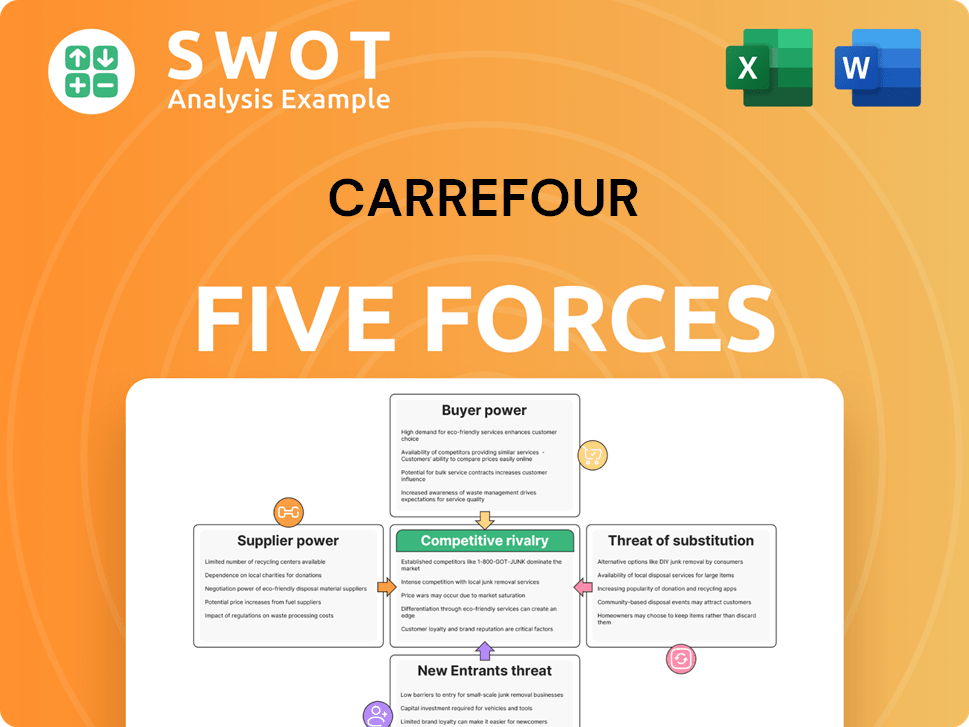
Related Blogs
- What are Mission Vision & Core Values of Carrefour Company?
- What is Competitive Landscape of Carrefour Company?
- What is Growth Strategy and Future Prospects of Carrefour Company?
- How Does Carrefour Company Work?
- What is Sales and Marketing Strategy of Carrefour Company?
- What is Brief History of Carrefour Company?
- What is Customer Demographics and Target Market of Carrefour Company?
Disclaimer
All information, articles, and product details provided on this website are for general informational and educational purposes only. We do not claim any ownership over, nor do we intend to infringe upon, any trademarks, copyrights, logos, brand names, or other intellectual property mentioned or depicted on this site. Such intellectual property remains the property of its respective owners, and any references here are made solely for identification or informational purposes, without implying any affiliation, endorsement, or partnership.
We make no representations or warranties, express or implied, regarding the accuracy, completeness, or suitability of any content or products presented. Nothing on this website should be construed as legal, tax, investment, financial, medical, or other professional advice. In addition, no part of this site—including articles or product references—constitutes a solicitation, recommendation, endorsement, advertisement, or offer to buy or sell any securities, franchises, or other financial instruments, particularly in jurisdictions where such activity would be unlawful.
All content is of a general nature and may not address the specific circumstances of any individual or entity. It is not a substitute for professional advice or services. Any actions you take based on the information provided here are strictly at your own risk. You accept full responsibility for any decisions or outcomes arising from your use of this website and agree to release us from any liability in connection with your use of, or reliance upon, the content or products found herein.